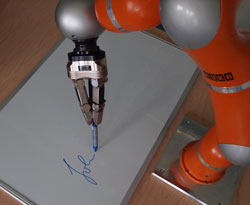Robot demonstrates human-like handwriting – researchers enable fluid writing and grasping movements

The robotic arm perfectly mimics a sample of handwriting. © Institut für Physik 3 - Biophysik, Univ. Göttingen<br>
This would allow future machines to be able to imitate handwriting, pour water into a glass or handle a dishwasher. The results were published online in the journal IEEE Transactions on Robotics.
Most human movements consist of a multitude of individual actions, which are connected to each other automatically. When a child learns to write, it initially guides the pen hesitantly. Over time, the child gradually learns to connect the individual letters to each other smoothly.
To date, however, machines work only through a chain of distinct motion elements. Scientists working with Prof. Dr. Florentin Wörgötter, coordinator of the Bernstein Focus Neurotechnology at the University of Göttingen, have now altered the mathematical basis of control commands in a few, but crucial, details. As a result, the robot can combine actions such as writing multiple letters connected to each other dynamically. Thus, robotic movements come much closer to the biological model than previously.
“In ten to fifteen years service robots will play a major role, so it is important that machine movement becomes more and more human-like, and thus predictable for us, so that we can work together without accidents,” explains Wörgötter.
The Minister for Science and Culture in the state of Lower Saxony, Prof. Dr. Johanna Wanka, was delighted by the capabilities of the robot demonstrated on a visit to the Bernstein Focus Neurotechnology and the Bernstein Center for Computational Neuroscience in Göttingen. After the Minister provided a handwritten sample, the robot mimicked it perfectly. “Now, our robot is the first to officially master ministerial handwriting,” said Prof. Wörgötter with a smile. “I am excited about the scientific results obtained at this location in Göttingen and I look forward to the many new possible applications for these technologies in the field of service robotics though I will continue to write my signature myself,” states the Minister.
The mathematical method that was further developed by the Göttingen scientists is particularly characterized by the fact that it can be easily transferred to different courses of action and produces extremely smooth movements. Thus, it could make a significant contribution to the development of robots that support humans in their daily lives in the future.
The Bernstein Focus Neurotechnology Göttingen is part of the National Bernstein Network Computational Neuroscience (NNCN) in Germany. The NNCN was established by the German Federal Ministry of Education and Research with the aim of structurally interconnecting and developing German capacities in the new scientific discipline of computational neuroscience. The network is named after the German physiologist Julius Bernstein (1835–1917).
Original Publication: Kulvicius T, Ning K, Tamosiunaite M, Wörgötter F (2011): Joining movement sequences: modified dynamic movement primitives for robotics applications exemplified on handwriting. IEEE Transactions on Robotics, doi: 10.1109/TRO.2011.2163863; September 1, 2011.
Contact:
Prof. Dr. Florentin Wörgötter
Georg-August-Universität Göttingen & Bernstein Center for Computational Neuroscience Göttingen
III. Institute of Physics – Biophysics
Friedrich-Hund-Platz 1, 37077 Göttingen
Phone: +49 (0)551 39-10760, Fax +49 (0)551 39-7720
E-Mail: worgott@physik3.gwdg.
Media Contact
All latest news from the category: Interdisciplinary Research
News and developments from the field of interdisciplinary research.
Among other topics, you can find stimulating reports and articles related to microsystems, emotions research, futures research and stratospheric research.
Newest articles

Parallel Paths: Understanding Malaria Resistance in Chimpanzees and Humans
The closest relatives of humans adapt genetically to habitats and infections Survival of the Fittest: Genetic Adaptations Uncovered in Chimpanzees Görlitz, 10.01.2025. Chimpanzees have genetic adaptations that help them survive…

You are What You Eat—Stanford Study Links Fiber to Anti-Cancer Gene Modulation
The Fiber Gap: A Growing Concern in American Diets Fiber is well known to be an important part of a healthy diet, yet less than 10% of Americans eat the minimum recommended…

Trust Your Gut—RNA-Protein Discovery for Better Immunity
HIRI researchers uncover control mechanisms of polysaccharide utilization in Bacteroides thetaiotaomicron. Researchers at the Helmholtz Institute for RNA-based Infection Research (HIRI) and the Julius-Maximilians-Universität (JMU) in Würzburg have identified a…



